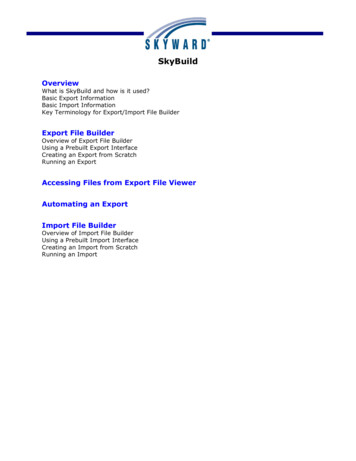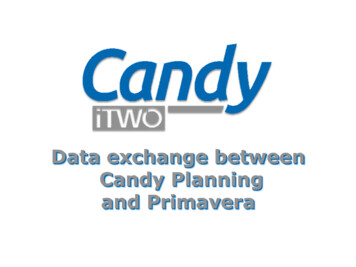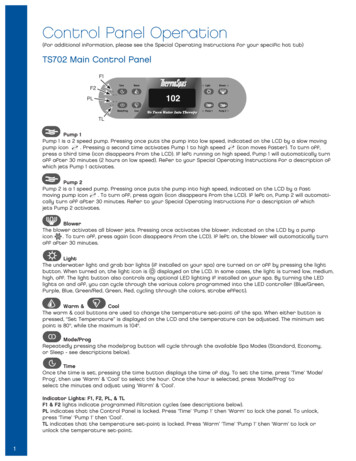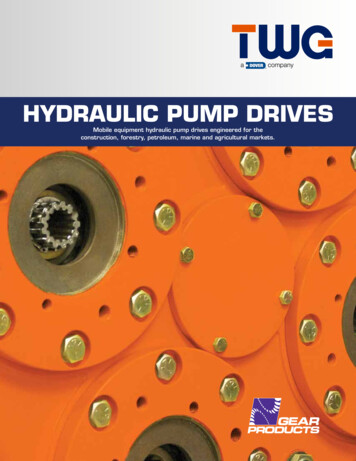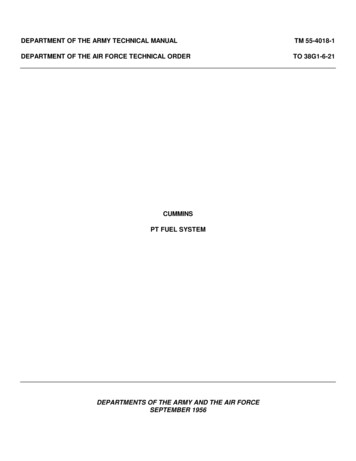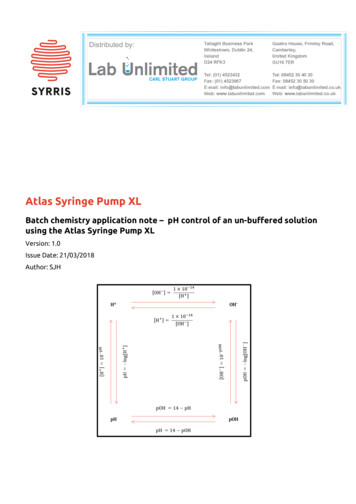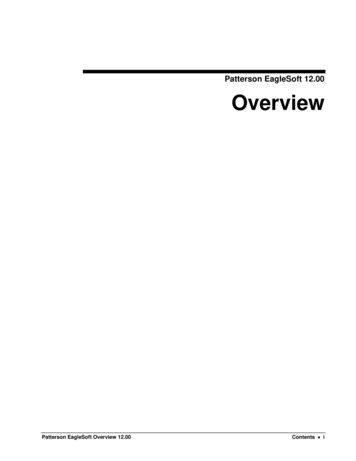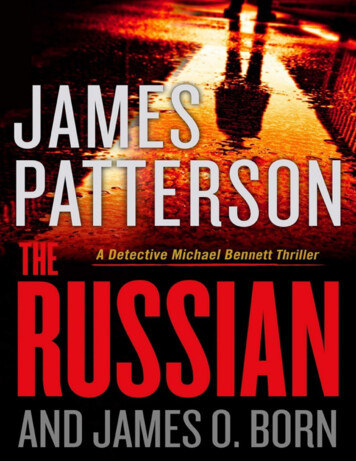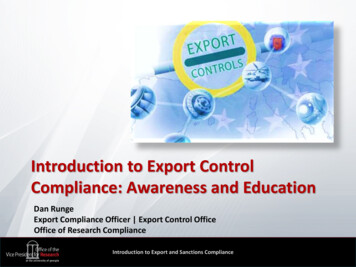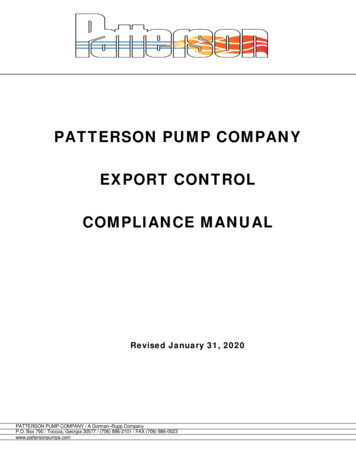
Transcription
PATTERSON PUMP COMPANYEXPORT CONTROLCOMPLIANCE MANUALRevised January 31, 2020PATTERSON PUMP COMPANY / A Gorman–Rupp CompanyP.O. Box 790 / Toccoa, Georgia 30577 / (706) 886-2101 / FAX (706) 886-0023www.pattersonpumps.com
TO:All Employees, Distributors and RepresentativesSUBJECT:Patterson Pump Company – Export Policy StatementAs a global company which operates in the United States, Patterson Pump Company is governedby U. S. export control rules and regulations regarding the export and/or re-export of products,spare parts, accessories, training materials and technical data. It is the policy of Patterson PumpCompany that under no circumstances will sales be made contrary to U. S. Export control law andregulations or the policies and procedures of Patterson Pump Company’s Export Managementand Compliance Program.Every employee, distributor or representative of Patterson Pump Company must remember thatexporting our products is a privilege, not a right, granted by the U. S. Government. This is criticalfor Patterson Pump Company because an increasing number of our sales take place in theinternational market place. Although most of our products do not require Export Licenses prior toshipment to most countries, many products are now more tightly controlled because of concernsregarding the proliferation of chemical and biological weapons, missile technology and nuclearweapons. Accordingly, Patterson Pump Company as an exporter must assume even greaterresponsibility for screening its customers and transactions. Careful review of both the end-useand the end-users involved with our international transactions is required to ensure export controlcompliance.Patterson Pump Company asks that each of you take this issue very seriously and support thecompany in this effort. If you have any questions concerning the legitimacy of a transaction orpotential violation, please contact:Mellissa Lynch, Vice President, Contract Compliance/Export Compliance OfficerTelephone: 706/297-2838 - Fax: 706/886-0023E-mail: mlynch@pattersonpumps.comwho is responsible for disseminating this Statement throughout the organization via PattersonPump Company’s Export Management and Compliance Program Manual updates, incorporationinto training and presentations, and posting on Patterson Pump Company’s Intranet and Website.Note: This Statement of Corporate Commitment to Export Compliance will be issued ifnecessitated by personnel changes, changes in management, or regulatory changes.PATTERSON PUMP COMPANY / A Gorman–Rupp Co.P.O. Box 790 / Toccoa, Georgia 30577 / (706) 886-2101 / FAX (706) 886-0023www.pattersonpumps.com
TABLE OF CONTENTS1.0INTRODUCTION . 32.0IDENTIFYING THE EXPORT . 43.0EXPORT CHECKLIST . 54.0EXPORT CONTROLS BASED ON THE NATURE OF THE PRODUCT . 75.06.07.04.1Bureau of Industry and Security (“BIS”) Controls . 104.2State Department Office of Defense Trade Controls . 134.3Nuclear Regulatory Commission Controls . 144.4Department of Energy Controls . 144.5Encryption Controls . 15EMBARGOES AND PROHIBITED EXPORT DESTINATIONS . 155.1Office of Foreign Assets Controls . 155.2Bureau of Industry and Security. 175.3Additional Defense Export Controls . 17PROHIBITED END-USES . 186.1Nuclear End-Uses . 196.2Missile End-Uses . 196.3Chemical and Biological Weapons End-Uses . 206.4Maritime Nuclear Propulsion End-Uses . 206.5Exports to Foreign Vessels . 20PROHIBITED PARTIES . 207.18.0Export Screening Lists for Individuals and Companies (SDN, Entity,Denied Parties, Unverified and Debarred Parties Lists) . 20FOREIGN CORRUPT PRACTICES ACT . 228.1General . 228.2Exceptions . 228.3Patterson Policy . 248.4FCPA “Red Flags” . 248.5FCPA Penalties . 24
9.010.0THE BRIBERY ACT 2011 (UNITED KINGDOM) . 259.1General . 259.2Exceptions . 259.3Patterson Policy . 259.4BA “Red Flags” . 269.5BA Penalties . 27U.S. DEPARTMENT OF COMMERCE AND INTERNAL REVENUESERVICE ANTIBOYCOTT CONTROLS . 2711.010.1Arab League Boycott of Israel: Generally . 2710.2Covered Conduct; Company Policy . 2810.3Records . 2910.4Penalties . 30NATIONAL INDUSTRIAL SECURITY PROGRAM . 3011.1General . 3011.2Classified Information . 3012.0RECORDKEEPING POLICY . 3113.0INTERNAL CONTROLS . 3314.0COMPLIANCE . 3515.0GENERAL TECHNOLOGY CONTROL PLAN. 3516.0GENERAL TECHNOLOGY CONTROL . 3516.1Company Overview . 3616.2Foreign National Visitors . 3716.3Foreign National Employees . 3816.4Information Sharing with Foreign Suppliers and Customers . 39Exhibit A – Certificate of Final Destination2
INTRODUCTIONIt is the policy of Patterson Pump Company (“Patterson”) to comply with all U.S.Government export control laws and regulations. No transactions are to beconducted by or on behalf of Patterson contrary to U.S. export regulations. Thiscompany supports U.S. efforts to fight the battle against terrorism and preventtransactions involving entities engaged in prohibited missile, nuclear, chemicaland biological warfare activities. In addition to affirming Patterson’s commitmentto full compliance with all applicable laws and regulations this manual is intendedto be used as a resource for ensuring compliance. In addition, this manual isdesigned to serve as a guide for Patterson’s employees (and outside partiesreviewing Patterson’s business practices) to company policies and proceduresrelated to embargo and export control compliance.The U.S. Government has the authority to control all exports from the UnitedStates. This authority is exercised by various agencies, including the Bureau ofIndustry and Security (“BIS”) at the Commerce Department, the Office of ForeignAssets Control (“OFAC”) at the Department of the Treasury, the Directorate ofDefense Trade Controls (“DDTC”) at the U.S. State Department, and numerousother agencies with smaller roles in export control. To enforce these regulationson exports, the U.S. Government restricts a limited number of exports andfinancial transactions based on: (1) the sensitive nature of the item to beexported, (2) the purpose for which the exported item will be used, (3) thecountry of destination, and (4) the identity of the end-user.Penalties for violations of U.S. export control laws and regulations may beimposed by law and may include substantial fines and/or imprisonment. Inaddition, violations could subject Patterson to administrative action, including thedenial of export privileges. Accordingly, Patterson will view the failure of anyemployee to comply with this policy statement as a violation of company policy,and, depending on the nature of the violation, the employee may be subject todisciplinary action, including a warning, reprimand placed in the personnel file,probation, suspension, reduction in salary, demotion, or dismissal. Violations willbe dealt with promptly.Any employee that has reason to suspect that a transaction is illegitimate or thata violation of the United States export regulations has either occurred or is aboutto occur is required to report his or her concerns immediately. Patterson has adesignated export compliance officer (ECO) who is the primary contact point forexport control and embargo issues. All company personnel are encouraged firstto communicate any questions or new issues involving embargoes or exports tothe ECO, who, in turn, will contact legal counsel when appropriate to ensure thatPatterson complies with U.S. laws.3
The official hard copy of the Manual will be maintained in the ContractDepartment by the ECO and will be updated from time to time as required bydevelopments in U.S. law.1.0IDENTIFYING THE EXPORTBefore determining whether export controls apply, it is important to determine justwhat is being exported. An export, by definition, is an actual shipment or transmission of items out of the United States. This includes items sent to militarybases or U.S. Navy vessels abroad, foreign affiliates and distributors, and anyforeign person, company, entity or government. Exports can be commodities,software, or technology. Exports include those sent via mail, freight forwarder,hand-carried with someone traveling abroad, and faxed, emailed or sent via otherelectronic means across the U.S. border. Re-export transactions involving shipments of U.S.-origin Patterson products from a foreign country to another foreigncountry are also controlled for export by U.S. laws and regulations. To the extentPatterson personnel know about such transfers in advance of export of ourproduct from the U.S., or we assist with or participate in such transactions,Patterson may need to ensure compliance with U.S. laws related to suchtransactions.“Technology” includes technical data and technical assistance that conveysspecific information “required” for the “development,” “production,” or “use” ofproducts, including drawings, operation, installation (including on-site installation), maintenance (checking), repair, overhaul and refurbishing instructions.Only certain technology relating to the development, production and use ofcontrolled products is controlled for export. Information that is publicly available(as strictly defined in the regulations) is not considered to be controlled forexport. Published standard manuals and items available to anyone over theinternet are not controlled for export. Typically, information required for the safeinstallation and operation of our products is not controlled for export so long asthe export of the product is legal without an export license or an export license orlicense exception is obtained or properly used. License exception TSU(Technology and Software Unrestricted) (found at 15 C.F.R. § 740) under theExport Administration Regulations (“EAR”) can be used for exports of mostinstallation and operation technology for licensable exports.An export of technology can occur by providing technical information related tocontrolled product(s) to anyone – including customers, suppliers, subsidiaries,employees or visitors – who is either in a foreign country or who is a foreignnational located in the U.S. An export violation would occur if the controlledtechnology was released without obtaining a license or properly using a license4
exception to a recipient located in a country that requires a license before thetechnology is released there or to a recipient who is a citizen of a controlledcountry regardless of where that citizen is located. This includes information sentvia e-mail and through other electronic means.A deemed export occurs within the U.S. when an exporter “releases” controlledtechnology to foreign nationals in the U.S. Technology is "released" when it ismade available to foreign nationals for visual inspection (such as readingtechnical specifications, plans, blueprints, etc.); when technology is exchangedorally; or when technology is made available by practice or application under theguidance of persons with knowledge of the technology. 1 Any foreign national(even a company employee) from a country requiring an export license for thecontrolled product(s) is subject to the "deemed export" rule except a foreignnational who (1) is granted permanent residence, as demonstrated by theissuance of a permanent resident visa (i.e., "Green Card"); (2) is granted U.S.citizenship; or (3) is granted status as a "protected person" under 8 U.S.C.§ 1324b(a)(3) (this is a specialized and rare refugee status).Again, exporters are responsible for both exports and reexports. A reexport is anactual shipment or transmission of items from one foreign country to anotherforeign country. Generally, the export or reexport of items that will transit througha country or countries, or be transshipped in a country or countries to a newcountry, or are intended for reexport to the new country, are deemed to beexports to the new country.2.0EXPORT CHECKLISTFor each proposed export either from the United States or of U.S. origin, thefollowing seven questions must be answered. If the answer to any question is“yes,” the item may require an export license before it can be exported legally,and you should contact the ECO before exporting the item. If necessary, theECO will contact legal counsel to discuss such exports in more detail beforeshipment occurs.(1)Do export or re-export controls apply to the item forforeign policy or national security reasons?BIS controls the export of certain items because their exportmay undermine a foreign policy or national security goal ofthe U.S. Government. Each item to be exported must have1See 15 C.F.R. § 734.2(b)(3)5
an Export Classification Control Number (“ECCN”). Thisnumber helps determine whether the company must obtainan export license for shipment of the item to the destinationcountry.(2)Is the item included on the U.S. Munitions List?The State Department controls the export of defense articlesand services, including ammunition, firearms, and militaryvehicles. Any item that is either on the munitions list locatedat 22 C.F.R., Part 121 or specially designed or modified formilitary use is subject to State Department export controls.(3)Is the item specially designed for nuclear uses?The Department of Energy and the Nuclear RegulatoryCommission control the export of articles and technologyrelated to nuclear facilities, including power plants andcertain nuclear materials.(4)Does the item contain encryption technology?BIS controls the export of many forms of encryptiontechnology.(5)Is the item being exported to a prohibited destination?(Prohibited destinations currently include Cuba, Iran, NorthKorea, Sudan and Syria).U.S. persons or entities may not export to these prohibiteddestinations or conduct any financial transactions involvingany of these prohibited locations, except in very limitedsituations that generally do not apply to Patterson. Inaddition, limited sanctions apply to many other countries.After determining that an export is bound for a destinationsubject to limited sanctions, you should carefully coordinateany activity with legal counsel before proceeding. See theOFAC Website at http://www.treas.gov/offices/enforcement/ofac/and Part 746 of the EAR for additional information on theselimited sanctions, which change from time to time.6
(6)Will the item be used for a prohibited end-use?Products cannot be exported from the United States withouta license if the exporter knows that the items will be used fornuclear, missile, chemical or biological weapons end-uses incertain designated countries, and for certain naval nuclearend uses.(7)Is the item being exported to a prohibited end-user?Prohibited end-users include individuals and entities who areaffiliated with embargoed governments, as well as certainterrorists, significant narcotics traffickers, those involved inillegal diamond trading practices and individuals who haveviolated export control and embargo laws. Current lists ofthese prohibited end-users are provided and updated by theresponsible government agency on a regular basis. Each ofthese lists must be consulted prior to exporting. See the BISwebsite for a collection of the lists to check which isavailable, along with the appropriate hyperlinks for use ListsToCheck.htm.If the answer to any of the above questions is “Yes”, the product, component ortechnology under consideration may require a license before it can be exported,or it may be prohibited from export.3.0EXPORT CONTROLS BASED ON THE NATURE OF THE PRODUCTCertain items require licenses before they can be exported from the UnitedStates because the nature of the product is such that its export would beinconsistent with a U.S. policy goal. This type of export control is generallyadministered by BIS in the Department of Commerce, the Department of Energy,the Department of State, or the Nuclear Regulatory Commission (“NRC”). Theexport of some items is controlled because the controlled items could contributeto the proliferation of missiles, the production of nuclear, chemical, or biologicalweapons in certain listed countries, the promotion of terrorist activities, and forseveral other national security reasons.For example, certain pumps or components of pumps and certain other chemicalprocessing equipment can be useful in developing and manufacturing chemicaland biological weapons. For this reason, a few Patterson products may becontrolled under the Export Control Classification Number (ECCN) 2B350 on the7
Commerce Control List (CCL) under the EAR. The text of the ECCN 2B350(i)control follows:i. Multiple-seal and seal-less pumps with manufacturer'sspecified maximum flow-rate greater than 0.6 m3/hour, orvacuum pumps with manufacturer's specified maximum flowrate greater than 5 m3/hour (under standard temperature(273 K (0 C)) and pressure (101.3 kPa) conditions), andcasings (pump bodies), preformed casing liners, impellers,rotors or jet pump nozzles designed for such pumps, inwhich all surfaces that come into direct contact with thechemical(s) being processed are made from any of the of thefollowing materials:i.1. Alloys with more than 25% nickel and 20% chromiumby weight;i.2. Nickel or alloys with more than 40% nickel by weight;i.3. Fluoropolymers;i.4. Glass (including vitrified or enameled coatings orglass lining);i.5. Tantalum or tantalum alloys;i.6. Titanium or titanium alloys;i.7. Zirconium or zirconium alloys;i.8. Niobium (columbium) or niobium alloys.i.9. Graphite or carbon-graphite;i.10. Ceramics; ori.11. Ferrosilicon.Products that meet the triggers described above (having multiple seals or beingseal-less, over the relevant flow rate, and made of the listed materials), pumpbodies, impellers, and liners for these pumps are controlled under the Chemicaland Biological Category “2” controls and require a license for export to over 150counties (most countries in the world), as identified in the BIS export regulations.8
See the Commerce Country Chart found at the following pir.pdf. Export control licensingrequirements apply to any country with an “X” in the box under the CB 2 or AT 1columns in the referenced country chart.In addition to the controls on certain pumps that are capable of handlingchemicals, there are other controls that directly affect Patterson pump products,including ECCN 2B999(j). That category covers “pumps designed for industrialservice and for use with an electrical motor of 5 HP or greater.” The 2B999ECCN category is specific to exports to North Korea, which is a very unusualexport destination for U.S. companies. However, because many Pattersonpumps fit into the 2B999(j) category, this ECCN listing must be used on exportdocuments for these pumps (Automated Export System submissions typicallyfiled by the company’s freight forwarders on the company’s behalf). An actualexport license is only required for shipments of these pumps to North Korea.It is also worth noting that a number of other common products are classified as2B999 items, including: monel equipment, including valves, piping, tanks andvessels; 304 and 316 stainless steel valves, piping, tanks and vessels; vacuumvalves, piping, flanges, gaskets and related equipment specially designed for usein high-vacuum service; and austenitic stainless steel plate, valves, piping, tanksand vessels, among other products.Certain precision ball bearings are classified as 1C999 products and arerestricted for export to a few destinations only, as indicated in the regulations.Also certain valves are controlled by ECCN’s 2A226 (certain bellows sealvalves), 2A292 (high pressure pipes and valves), 2A999 (all other bellows sealvalves).Unless they are for highly unusual material handling purposes or for nuclear enduses (under NRC controls or under ECCN 2A290 or 2A291, virtually all otherpumps are not controlled for export based on product classifications. In order toensure compliance with these product controls, the company should answer fivequestions about any item to be exported, particularly newly-produced items:(1)What is the Export Classification Control Number(“ECCN”) for the export?(2)Do export controls apply to that product for the countryof intended export after checking the “reason forcontrol” listed in the ECCN entry and the CommerceCountry Chart?9
(3)Is the export specially designed, produced, or adaptedfor nuclear use?(4)Is the export on the U.S. Munitions List or designed formilitary use?(5)Does the export contain encryption(Described later in this manual).technology?As discussed below, if the answer to any of these questions is “yes,” an exportlicense may be required before the item can be shipped legally out of the UnitedStates.3.1BUREAU OF INDUSTRY AND SECURITY (“BIS”) CONTROLSBIS exercises more control over exports than any other agency,particularly due to its authority over the export of “dual-use” items:those that are useful for both civilian and military purposes.BIS’s principal statutory authority is the Export Administration Act,which is implemented by the Export Administration allyatAlmost all itemshttp://www.gpo.gov/bis/ear/ear data.html.exported from the United States are subject to BIS jurisdictionbecause they are “subject to the EAR,” but only a small percentageof those items require an export license, such as the specializedpumps that fall in ECCN 2B350(i), as specified above.To determine whether an existing or new item requires an exportlicense before exporting or whether a license exception is available,Patterson completes several steps. First, the company examinesthe Commerce Control List (“CCL”) (Part 774, Supplement 1 of theEAR), which describes categories of items that are controlled underthe EAR in specific Export Control Classification Number (ECCN)categories. An easy way to begin this examination for a newlydeveloped product is by using the alphabetical index to the CCLlocated at . Usethe index as an initial guide to finding out if a product is covered byan ECCN category.If Patterson determines that an item is not classified in a controlledcategory in the CCL, that item falls into a “basket” category of itemssubject to the CCL, but not controlled for export under a specific10
ECCN category. Those products are referred to as an EAR99items. Generally, EAR99 items do not require an export license.Despite this general rule, EAR99 exports may still require a licensedue to “end use” (nuclear, chem/bio weapons, or missile uses) or“end user” concerns, as described below.BIS has a process for determining ECCN classifications forexporters if exporters are having difficulty determining where on thelist their products fall. This process, called an export classificationreview is initiated by signing up for access to an electronic licenseand classification application system called SNAPR.Seehttp://www.bis.doc.gov/SNAP/index.htm. If the company needslicenses or classification assistance in the future, it can sign up forthis system and apply for export licenses from BIS or ask BIS toclassify specific products.If Patterson determines that the item is listed in a controlled ECCNcategory, it must then determine the reason the item is controlledand whether that control applies to the country to which the item willbe exported. (Each ECCN category lists the reasons for control,e.g., antiterrorism, nuclear nonproliferation, chemical and biologicalweapons proliferation, etc.). Patterson must then look at po.gov/bis/ear/pdf/738spir.pdf) to determine ifthe destination country is affected by the applicable reason forcontrol.More specifically, as described above, a high nickel content alloypump (e.g. made from Inconel on its wetted surfaces) is controlledfor “CB2” chemical & biological proliferation reasons, as describedabove. These types of controls, however, do not apply to Canada(no “X” in the CB2 column of the CCL Country Chart entry forCanada for this type of control), so a shipment of this pump wouldnot require a license for export to Canada. This item would requirean export license, however, if it was being shipped to Brazil (whichhas an “X” in the CB2 column of the CCL Country Chart).Various models of Patterson’s pumps, including certain fire pumps,could be controlled under 2B350(i). Additionally, valves will becontrolled under 2B350(g) if they have an inside diameter of greaterthan 1 cm (3/8 in.) and all wetted paths are made of a nickelchromium alloy of more than 25% nickel and 20% chromium.Some of Patterson’s valves may fit this description.11
Pumps classified under 2B350(i) and valves classified under2B350(g) are controlled for both anti-terrorism and chemical andbiological weapons purposes. These items require licenses orlicense exceptions when exported to any country on the AT 1 2 orCB 2 3 lists in the country control chart. These lists can change andshould be consulted regularly when exporting 2B350 pumps orvalves.Even if an item is listed on the CCL and is subject to exportcontrols, a license exception may apply, meaning that the item maybe exported under a pre-approved exception to the licenserequirements. The EAR provide for a variety of license exceptions,such as shipments of limited value, temporary exports, andpersonal baggage. License exceptions must be evaluated withcare before use to ensure that every single condition of theexception is fully satisfied. If there are doubts about whether yourproduct qualifies for all aspects of a license exception, you shouldcontact counsel before exporting.Thus, items that: (1) are listed in the CCL, (2) are subject to controlfor the destination in question, and (3) do not qualify for a licenseexception, must be licensed for export by BIS prior to export.When considering whether to issue a license, BIS analyzes the2Currently, only Cuba, Iran, North Korea, Sudan and Syria are controlled under the AT 1 list.3Currently, the following countries are listed under CB 2: Afghanistan, Albania, Algeria, Andorra,Angola, Antigua and Barbuda, Argentina, Armenia, Aruba, Azerbaijan, The Bahamas, Bahrain,Bangladesh, Barbados, Belarus, Belize, Benin, Bhutan, Bolivia, Bosnia & Herzegovina, Botswana,Brazil, Brunei, Burkina Faso, Burma, Burundi, Cambodia, Cameroon, Cape Verde, Central AfricanRepublic, Chad, Chile, China, Colombia, Comoros, Congo (Democratic Republic of the), Congo(Republic of the), Costa Rica, Cote d’Ivoire, Cuba, Djibouti, Dominica, Dominican Republic, EastTimor, Ecuador, Egypt, El Salvador, Equatorial Guinea, Eritrea, Ethiopia, Fiji, Gabon, The Gambia,Georgia, Germany, Ghana, Grenada, Guatemala, Guinea, Guinea-Bissau, Guyana, Haiti, Honduras,Hong
Mellissa Lynch, Vice President, Contract Compliance/Export Compliance Officer . Telephone: 706/297-2838 - Fax: 706/886-0023 . E-mail: mlynch@pattersonpumps.com who is responsible for disseminating this Statement th roughout the organization via Patterson Pump Company's Export Management and Compliance Program Manual updates, incorporation
